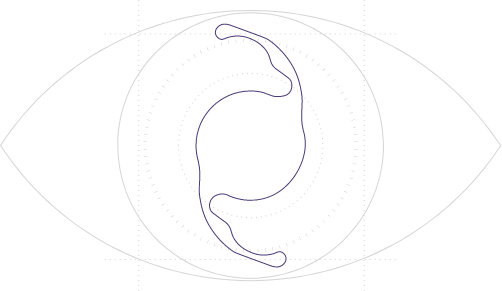

If you have a strong desire for greater independence from glasses or contacts, then you may want to consider an advanced intraocular lens (IOL) from one of our experienced ophthalmologists during your cataract or refractive lens exchange (RLE) surgery. There is a wide range of advanced IOLs that can help patients achieve improved vision, greatly reducing or possibly eliminating their need for corrective eye wear after surgery. Each lens option has a unique design, and may be able to improve distance, near, and intermediate vision. There are also advanced IOLs that can correct astigmatism at one distance or multiple distances. These lens options translate to greater freedom and independence for you at work, home, or wherever your hobbies and interests lead you.
A standard IOL is the type of lens implant used during standard cataract surgery, which is designed to improve vision at one distance. Most patients that opt to have a standard IOL choose to have their distance vision corrected, but they will likely need corrective eyewear after surgery to see at near and intermediate distances, or to correct astigmatism. Standard IOLs are typically covered by insurance.
If you desire to reduce your need for glasses or contact lenses after cataract or refractive lens exchange (RLE) surgery, then you may want to consider having Custom Cataract Surgery with an advanced IOL.
The Eye Institute of Utah offers the widest variety of advanced IOL options in Utah, with the goal of helping patients achieve the best possible vision outcomes. If you choose to have Custom Cataract Surgery with an advanced IOL, these lens options are considered non-covered, elective services by insurance companies. Patients often find that the out-of-pocket cost of an advanced IOL is well worth the investment since they can provide comprehensive vision correction with less dependence on glasses.
A toric IOL is an advanced lens option that can correct various degrees of astigmatism at a range of distances. Patients that choose to have astigmatism correction at the time of cataract surgery may still need to wear reading glasses after surgery, depending on the type of toric IOL implanted. At The Eye Institute of Utah, we offer a variety of toric IOLs, such as Clareon™ Toric IOL and the AcrySof® IQ Toric IOL.
Presbyopia correcting IOLs reduce or eliminate the need for reading glasses. For patients interested in the most visual freedom after RLE or cataract surgery, these IOLs can be the best solution. Starting around the age of 40-50, a majority of people begin to notice the sudden need for reading glasses to see up close. This common, age-related condition is called presbyopia. If you would like to correct your presbyopia and see clearly at all distances (near, intermediate, and far), then you should ask your doctor about presbyopia-correcting IOLs.
There are a few categories of Presbyopia-Correcting IOLs:
Multifocal IOLs
Trifocal IOLs
Accommodating IOLs
Extended-Depth-of-Focus IOLs
At The Eye Institute of Utah, we utilize a variety of brands of presbyopia-correcting lens implants, including PanOptix® trifocal IOL, AcrySof® IQ Vivity™ IOL, and AcrySof® IQ. Your eye doctor will explain your options and help choose the best IOL for you.
Alcon AcrySof® IQ PanOptix® trifocal intraocular lens is currently the only trifocal IOL approved by the FDA for use in the United States. PanOptix can improve near, intermediate and distance vision, making it a great choice for patients who would like to correct presbyopia as well as other refractive errors.
One of the greatest advancements in ophthalmology for patients struggling with reading glasses has been the FDA approval of advanced toric lenses These lenses are able to correct varying degrees of astigmatism, while simultaneously correcting near, intermediate, and distance vision.
Intraocular lenses that are light adjustable are the only type of lenses that can be customized by your eye surgeon after cataract or RLE surgery. The Eye Institute of Utah is proud to be the first vision practice in Utah to offer the RxSight Light Adjustable Lens™ system commercially. The RxSight light adjustable lens (RxLAL™) is made of a unique photo-sensitive material. Once your eyes are healed from surgery, your eye doctor can test your vision in order to adjust and customize your IOL prescription – making this the most customizable lens surgery available. This innovative technology allows for adjustments to be made without the need for additional surgery.
The post-operative treatment used to adjust your prescription is a quick, painless treatment in which UV light is non-invasively delivered to the lens. Patients with RxLAL typically have their first UV light treatment 2 to 3 weeks after surgery and a second UV light treatment approximately 3 days later. Additional light treatments may be administered if needed. The RxLAL allows your eye doctor to help you achieve accurate and precise vision correction.
In order to see which intraocular lens implant is best for you, you will need a thorough examination with a cataract specialist. Contact our office today to schedule your cataract examination!
Page Updated:
The Eye Institute of Utah Doctors have either authored or reviewed and approved this content.
